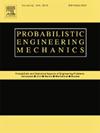A comparative analysis of intrusive and non-intrusive PCE methods for random mode computation
IF 3.5
3区 工程技术
Q2 ENGINEERING, MECHANICAL
引用次数: 0
Abstract
Random eigenmodes present a significant challenge in the analysis of uncertain dynamical systems, particularly when traditional Monte Carlo methods become computationally prohibitive for high-dimensional problems. While Polynomial Chaos Expansion (PCE) offers a promising alternative, the choice between intrusive (physics-based) and non-intrusive (data-driven) implementations remains a critical yet understudied decision. This paper presents the first comprehensive comparison of these PCE approaches for random eigenmode computation, examining their theoretical foundations, implementation complexities, and computational efficiency. Through systematic analysis of a three-degree-of-freedom system with varying uncertainty parameters, we demonstrate that intrusive PCE achieves superior accuracy for low-dimensional problems, while non-intrusive PCE shows better scalability for higher-dimensional systems. Our findings reveal a previously undocumented trade-off between implementation complexity and computational efficiency, establishing clear criteria for approach selection based on problem dimensionality and accuracy requirements. These insights extend beyond modal analysis to the broader field of uncertainty quantification in computational mechanics, providing practical guidelines for selecting optimal PCE strategies in various engineering applications. The methodological framework presented here opens new possibilities for efficient uncertainty analysis in large-scale dynamical systems.
随机模态计算中侵入式与非侵入式PCE方法的比较分析
随机特征模态在不确定动力系统的分析中提出了一个重大的挑战,特别是当传统的蒙特卡罗方法对高维问题的计算变得令人望而却步时。虽然多项式混沌展开(PCE)提供了一个很有前途的替代方案,但在侵入式(基于物理的)和非侵入式(数据驱动的)实现之间的选择仍然是一个关键但尚未得到充分研究的决定。本文首次对这些随机特征模计算的PCE方法进行了全面比较,考察了它们的理论基础、实现复杂性和计算效率。通过对具有不同不确定参数的三自由度系统的系统分析,我们证明了侵入式PCE在低维问题上具有更好的精度,而非侵入式PCE在高维问题上具有更好的可扩展性。我们的研究结果揭示了以前没有记录的实现复杂性和计算效率之间的权衡,建立了基于问题维度和精度要求的方法选择的明确标准。这些见解从模态分析扩展到计算力学中更广泛的不确定性量化领域,为在各种工程应用中选择最佳PCE策略提供了实用指南。本文提出的方法框架为大规模动力系统的高效不确定性分析开辟了新的可能性。
本文章由计算机程序翻译,如有差异,请以英文原文为准。
求助全文
约1分钟内获得全文
求助全文
来源期刊

Probabilistic Engineering Mechanics
工程技术-工程:机械
CiteScore
3.80
自引率
15.40%
发文量
98
审稿时长
13.5 months
期刊介绍:
This journal provides a forum for scholarly work dealing primarily with probabilistic and statistical approaches to contemporary solid/structural and fluid mechanics problems encountered in diverse technical disciplines such as aerospace, civil, marine, mechanical, and nuclear engineering. The journal aims to maintain a healthy balance between general solution techniques and problem-specific results, encouraging a fruitful exchange of ideas among disparate engineering specialities.
 求助内容:
求助内容: 应助结果提醒方式:
应助结果提醒方式:


